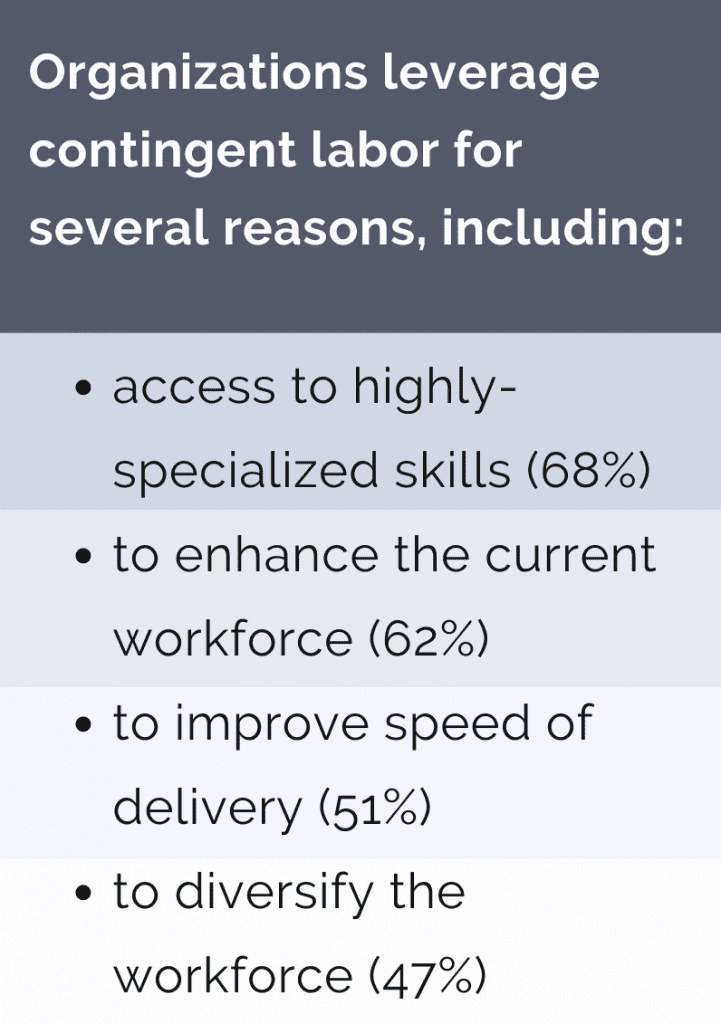By leveraging a direct sourcing solution, organizations can attract and onboard the best available candidates as quickly as possible.
By Debbie Bolla
With Ardent Partners reporting that 43% of an overall workforce is considered contingent, it’s become a business imperative that organizations have detailed sourcing and management strategies around this talent category. If they do, they are well positioned to reap many benefits. In fact, Ardent Partners’ The State of Contingent Workforce Management 2020 finds that organizations leverage contingent labor for several reasons, including access to highly-specialized skills (68%); to enhance the current workforce (62%); to improve speed of delivery (51%); and to diversify the workforce (47%).
“Companies have come to realize that leveraging a flexible, fluid workforce is not just a nice to have, it is becoming a core part of their talent strategy,” says Mike Wachholz, CEO of Geometric Results, Inc. (GRI), a leading independent MSP. “COVID-19 really has had a pinwheel effect on this trend.”
The pandemic has only exacerbated the need for an agile workforce, with the majority of offices moving to remote environments and employees seeking support in a multitude of ways.
“Workers are expecting a lot more in terms of their connectivity to companies, their relevance and alignment with culture, and the social purpose of businesses,” Wachholz explains. “All of those things have had a really big impact on how contract workers want to be engaged by a company.”
 One approach that benefits organizations and contingent workers alike is a direct sourcing strategy through an MSP. With a direct sourcing solution, organizations have a captive sourcing model that leverages their brand and network to ensure the best available candidates are selected for the position as quickly as possible. Talent pools are swelling with this model, encompassing all worker types including contractors, silver medalists, alumni, retirees, and temp-to-perm workers.
One approach that benefits organizations and contingent workers alike is a direct sourcing strategy through an MSP. With a direct sourcing solution, organizations have a captive sourcing model that leverages their brand and network to ensure the best available candidates are selected for the position as quickly as possible. Talent pools are swelling with this model, encompassing all worker types including contractors, silver medalists, alumni, retirees, and temp-to-perm workers.
Through direct sourcing, the candidate is also back in the driver’s seat since they are directly connected to the company they want to work for because they are linked to opportunities through a private talent cloud. This type of solution allows candidates to have direct and timely access to new temp positions as soon as they become available.
Direct sourcing also offers a greater reach to temp workers. “The ability to attract talent in new markets, the ability to attract emerging skill sets, and the ability to drive much better outcomes from a diversity and inclusion perspective is paramount today,” he says. “This type of engagement model allows companies to do that.”
HR and TA leaders are beginning to eye these advantages, with Ardent Partners’ research finding that 69% of respondents report that direct sourcing is a top area of focus for the next two years. Companies leveraging this model will experience myriad benefits to the bottom line, including reduced costs to fill positions, upticks in time-to-fill rates, an increase in talent productivity, and faster onboarding times.
So what factors should organizations consider? Wachholz recommends:
- Managing contingent workers with the same amount of care and diligence as other talent across the supply chain.
- Communicating employer brand to all worker types through social media channels.
- Involving marketing and HR to ensure sure there’s a tight process and strategy around how contingent labor interacts with the overall brand.
- Integrating tech platforms, including ATSs, VMSs, and CRMs, for easy access to data through a robust and transparent dashboard.
- Leveraging the organization’s vast network of touchpoints to engage contract workers.














